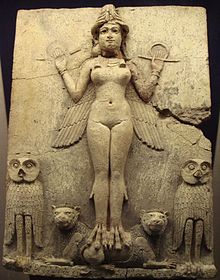This article needs additional citations for verification. (January 2022) |


The rod-and-ring symbol is a symbol that is depicted on Mesopotamian stelas, cylinder seals, and reliefs. It is held by a god or goddess and in most cases is being offered to a king who is standing, often making a sacrifice, or otherwise showing respect. The symbol dates from the Third Dynasty of Ur to the Neo-Assyrian period, and is commonly explained as a coil of measuring string and a yardstick.[1] Other theories are that they are a shepherd's crook and a nose rope,[2] or that the ring is no rope at all.[3]
The best known example of the symbol is seen on the Code of Hammurabi stela. The symbol is also illustrated in the "Investiture Scene" painted at the palace of Mari.[4] The most elaborate depiction is found on the Ur-Nammu-stela, where the winding of the cords has been detailed by the sculptor. This has also been described as a "staff and a chaplet of beads".[5] There is discussion whether the Ur-Nammu-stela is showing the same thing.
- ^ Jacobsen, 1987
- ^ Hallo, W.W. 2005. Sumerian history in pictures: a new look at the 'Stele of the Flying Angels', in: Y. Sefati et al (eds), 'An Experienced Scribe who Neglects Nothing': Ancient Near Eastern Studies in Honor of Jacob Klein. Bethesda, MD: CDL Press, 142-62.
- ^ Van Buren, E.D. 1949. The rod and ring. ArO 17 (2), 434-50.
- ^ Knott, Elizabeth (2021-09-21), "Mari's Investiture Scene and the Visualization of Kingship in the Old Babylonian Period", As Above, So Below, Penn State University Press, pp. 74–114, doi:10.5325/j.ctv1xx9msm.7, ISBN 9781646021536, S2CID 240527251, retrieved 2022-12-17
- ^ Jeremy Black, Anthony Green, Gods, Demons and Symbols of Ancient Mesopotamia, Rod and Ring, p 156.
© MMXXIII Rich X Search. We shall prevail. All rights reserved. Rich X Search
